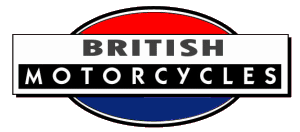

Notes on some of the rarer British marques
This page lists brands for which we currently have only an historical precis.
For a more complete listing visit the British Index.
Carden Monocar
Manufactured in 1914 by the Carden Engineering Co Ltd, who were associated with the Carette Company. The designer was John Valentine Carden, a talented man who later became involved in aviation. The design was sold to Tamplin Engineering Co of Middlesex.
Source: period advertising.
Carlton Motor Co
The Carlton Motor Co of Cricklewood, London, manufactured carburettors and engines for cars and motorcycles from 1902. These engines were fitted to the Fly motorcycle of 1902. The firm, owned by Arthur Gower, was absorbed in 1902 by Coronet of Coventry, whose chief engineer was Walter Eden [1]. Coronet built cars and automobile engines, and reportedly built motorcycles in their first years.
Further information on Carlton: Stanley Show 1902
Sources: Graces Guide, The Motor Cycle.
N.B.
1. Possibly Walter Iden.
2. Unrelated to Frederick Hanstock's Coventry firm which built Carlton Motorcycles (1922-1940).
Castle Sidecars
Manufactured by Castle Cabinet Company (C.C.C.) of Spon Lane, West Bromwich, from around 1950 to 1956. Earlier models used chassis supplied by Watsonian, and some had sidecar suspension. Models included Princess, Countess, Diplomat, Envoy and Ambassador.
Jaguar, previously known as Swallow Side Cars, was located nearby, at Castle Bromwich. Watsonian took over the Swallow sidecar business.
Sources: Gespann-Lexikon, et al.
Castle Three
Manufactured by the Castle Three Motor Company of Kidderminster, Worcestshire, the cyclecar was similar in style to the 3-wheeled Morgan but was somewhat heavier and did not qualify for the tax reduction as a result. Powered by a four-cylinder Dorman engine, and later by a slightly larger Peters, they built around 350 vehicles between 1919 and 1922 when they introduced the Castle Four. Production ceased around that time.
Source: 3-wheelers.com
Celtic
Manufactured by the Celtic Cycle Co of Dublin, early 1900s
A 1903 Celtic fitted with a 188cc FN engine was part of the Harry Lindsay collection, and is the only known survivor.
The firm was an engineering company which made wheels and had an early involvement in tyres. They made bicycles which were sold in Ireland and London before building motorcycles. They later moved to Great Ship Street next to Dublin Castle as Lindsay & Sons and remained in business until about 1990 when the third generation to run the business retired.
Source: Robert Nason in the Motorcycles 1867-1930 FB Group.
C & H Cyclecar
Built by Corfield and Hurle, Stamford Hill, 1912-1913
Three-wheeler, tadpole style, chain drive to the rear wheel. Fafnir 5-6 h.p. water-cooled V-twin engine, Chater-Lea 3 speed gearbox. They were also available with a 964 cc 8 h.p. Precision engine.
Sources: The Motor Cycle, Graces Guide.
Charnwood
Charnwood Classic Restorations of Hugglescote, Leicestershire
Their website was charnwoodclassic.com ✝
Formerly located in Coalville, the business was bought by by Jez and Jude Beswick, who moved it to Gelders Hall Road in Shepshed near Loughborough, not far from the original site.
Their prime model was the Charnwood Royal, others being the Meteor and the Sport.
Sources: real-classic.co.uk, et al
Cheviot c.1903~1910
C&M Sidecars
Manufactured in 1920 by Capjon & Mudd Engineers Durham Wharf, The Mall, Hammersmith
Source: The Motor Cycle February 3rd 1921
Collinge
Built in 1949 for speed records, the streamliner was fitted with a 500cc horizontally opposed four-cylinder engine and a cigar-shaped body in which the rider lay prone.
Source: wikipedia.nl
Combidrive
Manufactured by Combidrive of Wales, the Combidrive Mouse has a 265cc diesel engine which propelled the vehicle to a world's record of 568 miles per gallon in 1996.
Sources: 3-wheelers.com, http://combidrive.com/the-mouse
Consul
Small assembler who produced Villiers engined 269 and 247cc models with orthodox frames.
Source: Tragatsch p 107
Coronet
Manufactured by Coronet Motor Co. Ltd. 1903-1906
Founded in Coventry as a motorcycle manufacturer, few examples were built before they switched to the production of automobiles in 1904. Chief Engineer was Walter Eden, son of George Eden who had designed several cars for the MMC Motor Manufacturing Company.
Using mainly British components around 4 Coronet cars were produced before the firm was absorbed by Humber in 1906.
Source: Autopasion18.com
County Sidecars
Manufactured by County Cycle & Motor Company, 300 & 301 Broad Street, Birmingham. 1920-1922
Source: The Motor Cycle, 1922
Coventry Duplex
"The Coventry Duplex Co.'s motor bicycle with Motosacoche attachment. Note the special construction of the front fork."
Source: The Motor Cycle, 1907
Crampton
Crampton Motorcycle Manufacturing Company
"An exclusive, limited edition, hand-built motorcycle made in England using British parts wherever possible combining traditional appearance and craftsmanship with modern performance."
Website: iancramp.co.uk
Crayshaw
Built by Mr. Raymond V. E. de B. Crawshaw in 1910, this very attractive rear wheel drive tricycle is thought to have been a one-off.
Source: The Motor Cycle
Crossley Brothers 1900s
Crouch Three-wheelers 1912-1928
Rarer British Marques